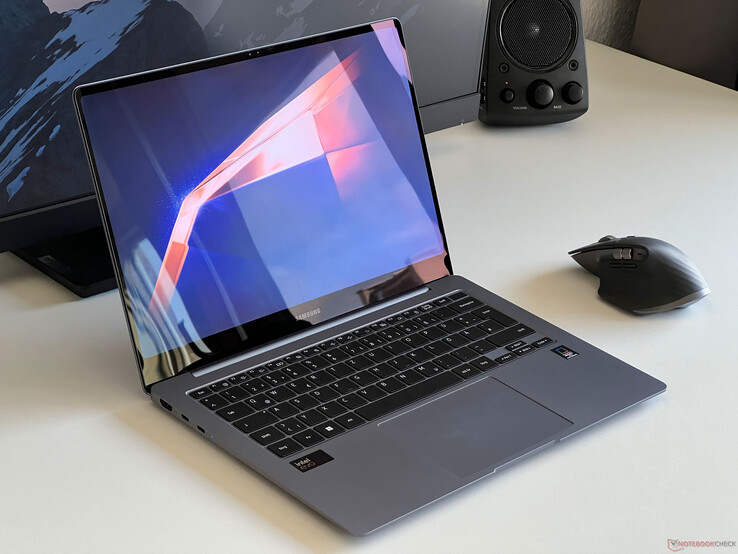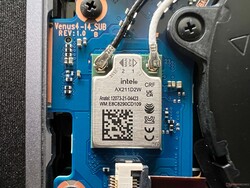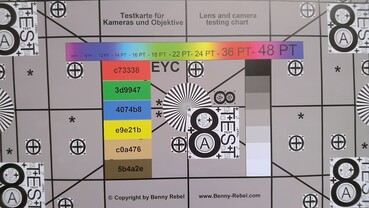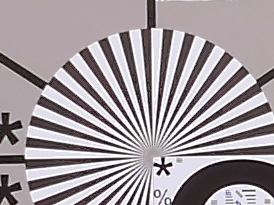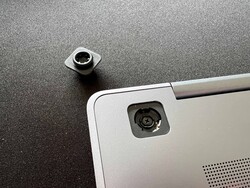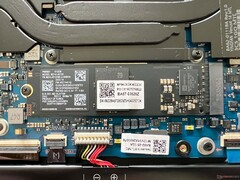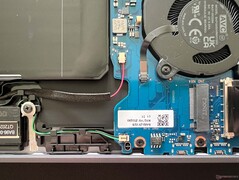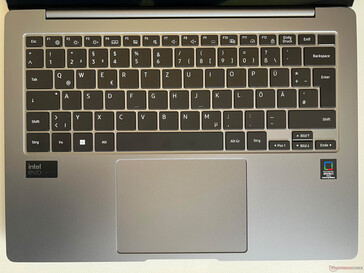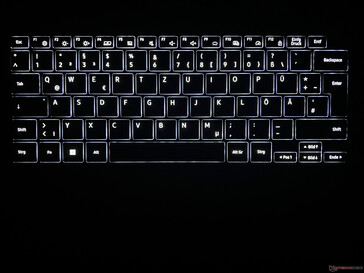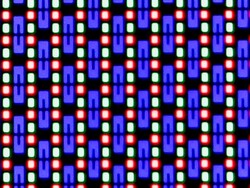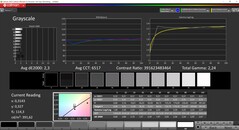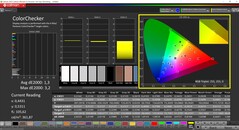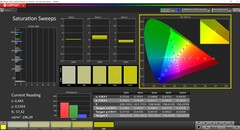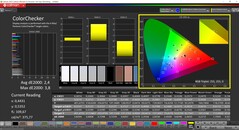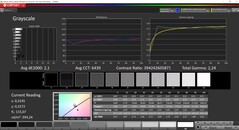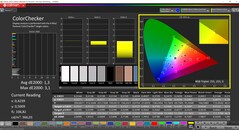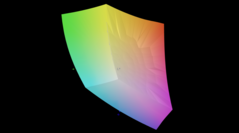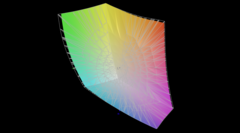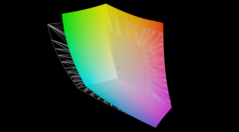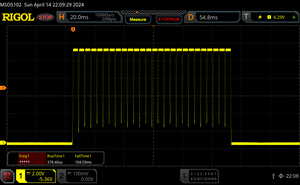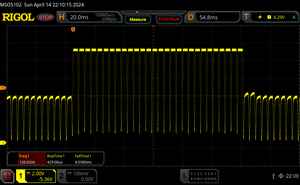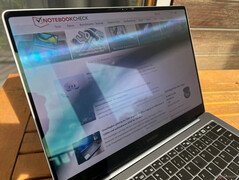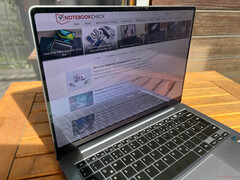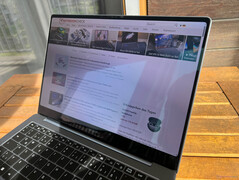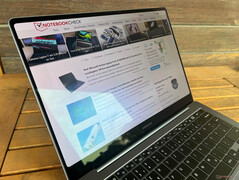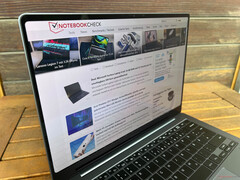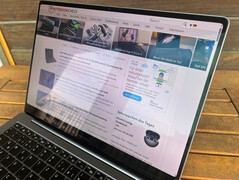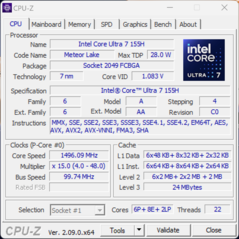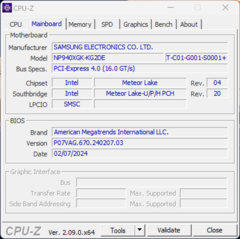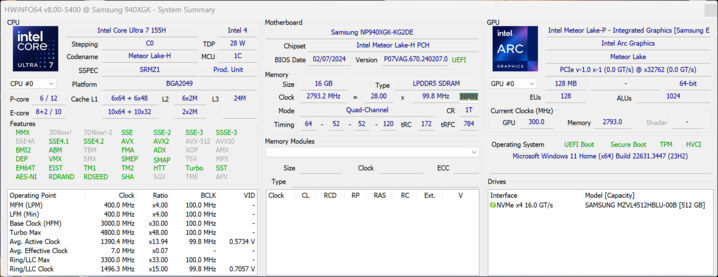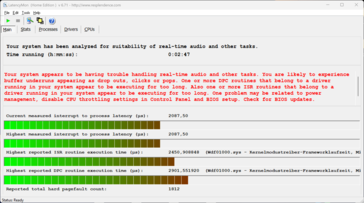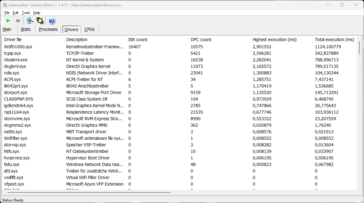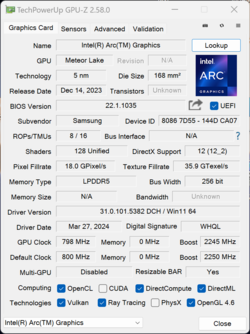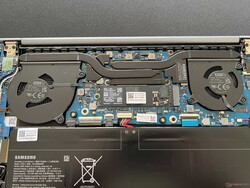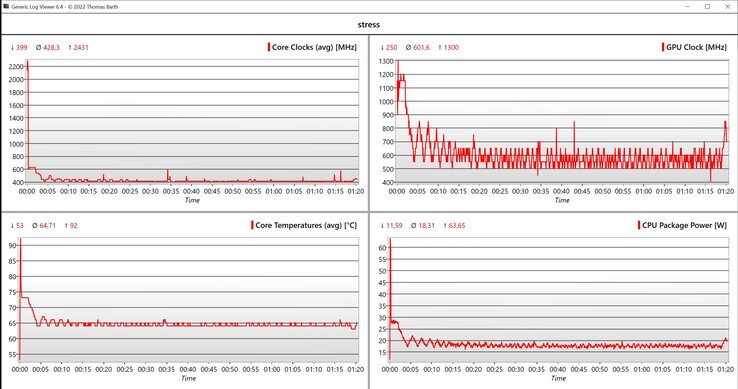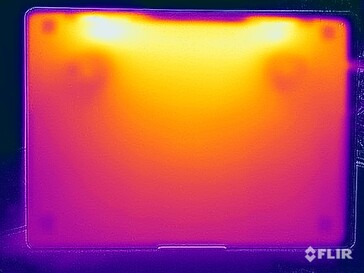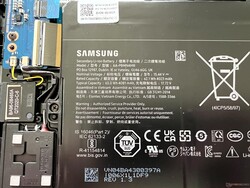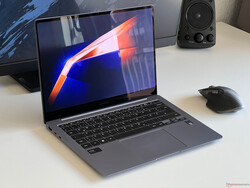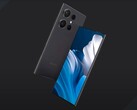Samsung Galaxy Book4 Pro 14 review – Expensive everyday laptop with OLED touch screen
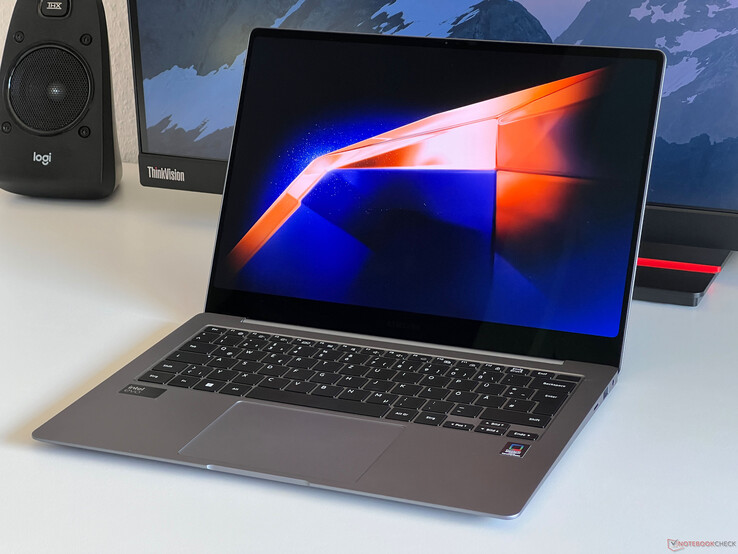
The Galaxy Book4 Pro is currently Samsung's only 14-inch notebook and it's directed at users looking for a slim and light notebook with decent performance and good image quality. As with the larger 16-inch model (read the review here), this device comes in only one configuration, though users do have a choice between 512 GB (our test unit) or 1 TB of storage capacity. Other specs include the current gen Intel Core Ultra 7 155H with Arc Graphics, a high-resolution 120-Hz OLED touch screen, and 16 GB of RAM. Starting at $1,450, the Galaxy Book4 certainly isn't cheap.
Possible competitors in comparison
Rating | Date | Model | Weight | Height | Size | Resolution | Price |
|---|---|---|---|---|---|---|---|
| 87.4 % v7 (old) | 04 / 2024 | Samsung Galaxy Book4 Pro 14 Ultra 7 155H, Arc 8-Core | 1.2 kg | 11.6 mm | 14.00" | 2880x1800 | |
| 89.6 % v7 (old) | 06 / 2023 | Huawei MateBook X Pro 2023 i7-1360P, Iris Xe G7 96EUs | 1.3 kg | 15.6 mm | 14.20" | 3120x2080 | |
| 88.3 % v7 (old) | 03 / 2024 | Lenovo Yoga Slim 7 14IMH9 Ultra 7 155H, Arc 8-Core | 1.4 kg | 14.9 mm | 14.00" | 1920x1200 | |
| 86.7 % v7 (old) | 02 / 2024 | Asus ZenBook 14 UX3405MA Ultra 7 155H, Arc 8-Core | 1.2 kg | 14.9 mm | 14.00" | 2880x1800 | |
| 88.2 % v7 (old) | 10 / 2023 | Lenovo Yoga Slim 7 14APU G8 R7 7840S, Radeon 780M | 1.3 kg | 13.9 mm | 14.50" | 2944x1840 | |
| 90 % v7 (old) | 08 / 2023 | LG Gram Style 14Z90RS-G.AD7AG i7-1360P, Iris Xe G7 96EUs | 987 g | 16.5 mm | 14.00" | 2880x1800 | |
| 92.4 % v7 (old) | 03 / 2024 | Apple MacBook Air 13 M3 10C GPU M3, M3 10-Core GPU | 1.2 kg | 11.3 mm | 13.60" | 2560x1664 |
Case – The Galaxy Book4 is very slim
The Galaxy Book4 Pro has the same basic design as its predecessor and is extremely slim, as discussed in our review of the larger 16-inch model. However, the thick rubber feet at the rear somewhat compensate this. The design is very simple and the entire notebook gives an impression of high quality and good workmanship. The dark gray surfaces aren't particularly susceptible to fingerprints either, though they, too, will need to be cleaned from time to time. We're not too impressed by the very wide lower bezel (2 cm).
There is no need for compromises in terms of stability. Desite its slim form factor, the base unit is very sturdy and we detected no warping or creaking. Only the center of the keyboard will give way minimally under pressure. The lid is warp-resistant as well and the hinges are well adjusted, with only the slightest wobble remaining. The display is easy to open with just one hand thanks to the recess in the base unit. The maximum opening angle is 135°.
Only the MacBook Air M3 is even thinner and more compact than our Galaxy Book4, though it has more or less the same footprint as the Windows devices. Our test unit weighs about 1.23 kg and can easily be transported in bags and backpacks. The 65-W AC adapter weighs only 163 grams including the USB-C cable.
Connectivity - Thunderbolt and Wi-Fi 6E
The large 14-inch Galaxy Book4 Pro has excellent connectivity options including the modern Thunderbolt 4, USB-A and an HDMI output. Users will not need to rely on adapters for everyday use.
SD Card Reader
The microSD card slot is positioned on the right side of the device and is large enough for the memory card to be fully inserted. In fact, the spring mechanism is so far inside the device that it can be difficult to insert and remove the card. The maximum transfer rate using our reference card (Angelbird AV Pro V60) is over 80 MB/s, though we measured just over 40 MB/s when copying images.
| SD Card Reader | |
| average JPG Copy Test (av. of 3 runs) | |
| LG Gram Style 14Z90RS-G.AD7AG (AV PRO microSD 128 GB V60) | |
| Average of class Office (22.4 - 198.5, n=31, last 2 years) | |
| Samsung Galaxy Book4 Pro 14 (Angelbird AV Pro V60) | |
| maximum AS SSD Seq Read Test (1GB) | |
| Samsung Galaxy Book4 Pro 14 (Angelbird AV Pro V60) | |
| LG Gram Style 14Z90RS-G.AD7AG (AV PRO microSD 128 GB V60) | |
| Average of class Office (25 - 249, n=27, last 2 years) | |
Communication
While Samsung has chosen not to implement Wi-Fi-7, the AX211 module still provides a modern Wi-Fi adapter that supports Wi-Fi-6E in 6-GHz networks as well as Bluetooth 5.3. The transfer rates measured with our Asus reference router weren't record-breaking but still very high. Users should encounter no issues when it comes to wireless performance in everyday use.
| Networking | |
| Samsung Galaxy Book4 Pro 14 | |
| iperf3 transmit AXE11000 | |
| iperf3 receive AXE11000 | |
| Huawei MateBook X Pro 2023 | |
| iperf3 transmit AXE11000 | |
| iperf3 receive AXE11000 | |
| iperf3 transmit AXE11000 6GHz | |
| iperf3 receive AXE11000 6GHz | |
| Lenovo Yoga Slim 7 14IMH9 | |
| iperf3 transmit AXE11000 | |
| iperf3 receive AXE11000 | |
| iperf3 transmit AXE11000 6GHz | |
| iperf3 receive AXE11000 6GHz | |
| Asus ZenBook 14 UX3405MA | |
| iperf3 transmit AXE11000 | |
| iperf3 receive AXE11000 | |
| Lenovo Yoga Slim 7 14APU G8 | |
| iperf3 transmit AXE11000 | |
| iperf3 receive AXE11000 | |
| LG Gram Style 14Z90RS-G.AD7AG | |
| iperf3 transmit AXE11000 | |
| iperf3 receive AXE11000 | |
| iperf3 transmit AXE11000 6GHz | |
| iperf3 receive AXE11000 6GHz | |
| Apple MacBook Air 13 M3 10C GPU | |
| iperf3 transmit AXE11000 | |
| iperf3 receive AXE11000 | |
Webcam
The 1080p webcam has remained unchanged with average quality. It does not feature a mechanical shutter nor an IR module for face recognition. Thanks to the Meteor Lake chips' new NPU, however, the operating system now supports studio effects (blurred backgrounds, eye contact, head tracking) directly, irrespective of the app used.
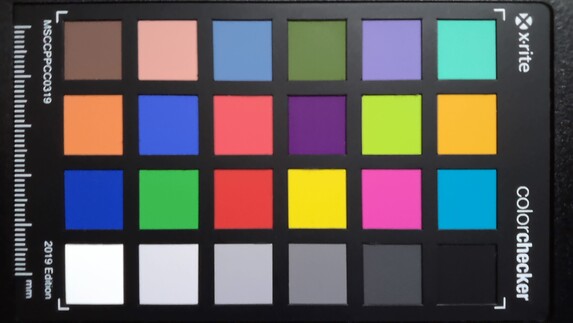
Maintenance
The cover of the base unit is secured using four regular Philipps screws that are hidden beneath rubber feet. Fortunately, these are not glued on and are thus easy to remove. The cover is additionally fixed by clips, so we would recommend using a small suction cup to remove it. Once inside, we were pleasantly surprised by the presence of a free M.2 2280 SSD slot in our 512-GB configuration, which makes expanding the storage space fairly easy and affordable. The same cannot be said of the RAM and Wi-Fi modules, which are soldered on.
Input Devices – Galaxy Book with a touch screen
The Galaxy Book4 Pro 14 goes without the 16-inch model's dedicated numpad but offers the same typing experience. While travel is limited, the keyboard feels crisp. We would still recommend frequent typists try out the keyboard before purchase. The only bothersome aspects of the layout are the very small arrow keys and the power button (and fingerprint reader) in the top right corner, which can easily be confused with the delete key. The white backlighting has three levels of brightness.
The ClickPad is 11.5 x 8.2 cm large and provides plenty of space as well as good gliding properties. We did not encounter any problems when using the ClickPad, although the clicking can be rather loud. The capacitive touch screen can also be used as an input device and works perfectly well.
Display – 120 Hz OLED touch screen
The Galaxy Book4 Pro is equipped with a 14-inch OLED touch screen with a resolution of 2880 x 1800 pixels and a 16:10 aspect ratio. Subjectively speaking, the image quality is excellent, with the qualities of an OLED panel (vibrant colors, true blacks, fast response rates) combined with the fact that there is no grid effect visible on light areas despite the touch screen. On the downside, we measured PWM flickering at 240 Hz at all brightness levels.
The maximum SDR brightness is 400 cd/m². The 0 cd/m² black value leads to an extremely high contrast ratio. In HDR mode (which has to be activated manually), the maximum brightness increases to 580 cd/m² both on a small image section and across an almost entirely white screen. The OLED comparison devices all perform similarly, with only the two IPS models achieving higher brightness values in SDR mode.
| |||||||||||||||||||||||||
Brightness Distribution: 97 %
Center on Battery: 392 cd/m²
Contrast: ∞:1 (Black: 0 cd/m²)
ΔE ColorChecker Calman: 1.3 | ∀{0.5-29.43 Ø4.78}
ΔE Greyscale Calman: 2.3 | ∀{0.09-98 Ø5}
85.2% AdobeRGB 1998 (Argyll 3D)
100% sRGB (Argyll 3D)
97% Display P3 (Argyll 3D)
Gamma: 2.24
CCT: 6517 K
| Samsung Galaxy Book4 Pro 14 ATNA40CU07-0, OLED, 2880x1800, 14" | Huawei MateBook X Pro 2023 TMX1422, IPS, 3120x2080, 14.2" | Lenovo Yoga Slim 7 14IMH9 LEN140WUXGA, OLED, 1920x1200, 14" | Asus ZenBook 14 UX3405MA ATNA40CU06-0, OLED, 2880x1800, 14" | Lenovo Yoga Slim 7 14APU G8 LEN145WQ+, OLED, 2944x1840, 14.5" | LG Gram Style 14Z90RS-G.AD7AG Samsung SDC417F ATNA40YK10-1, OLED, 2880x1800, 14" | Apple MacBook Air 13 M3 10C GPU IPS, 2560x1664, 13.6" | |
|---|---|---|---|---|---|---|---|
| Display | -3% | 6% | 6% | 1% | 5% | 1% | |
| Display P3 Coverage (%) | 97 | 89.8 -7% | 99.8 3% | 99.8 3% | 97.1 0% | 99.92 3% | 98.4 1% |
| sRGB Coverage (%) | 100 | 99.4 -1% | 100 0% | 100 0% | 100 0% | 100 0% | 99.9 0% |
| AdobeRGB 1998 Coverage (%) | 85.2 | 84.2 -1% | 97.3 14% | 97.6 15% | 86.5 2% | 94.71 11% | 87.9 3% |
| Response Times | -1612% | -174% | 7% | -7% | -166% | -3950% | |
| Response Time Grey 50% / Grey 80% * (ms) | 0.83 ? | 20 ? -2310% | 1.78 ? -114% | 0.69 ? 17% | 0.77 ? 7% | 2 ? -141% | 34.5 ? -4057% |
| Response Time Black / White * (ms) | 0.69 ? | 7 ? -914% | 2.3 ? -233% | 0.71 ? -3% | 0.83 ? -20% | 2 ? -190% | 27.2 ? -3842% |
| PWM Frequency (Hz) | 240 ? | 156000 ? | 489.7 ? | 480 ? | 360 ? | 350 | |
| Screen | -19% | -56% | 14% | 10% | -24% | 12% | |
| Brightness middle (cd/m²) | 392 | 595 52% | 388.3 -1% | 391 0% | 387 -1% | 384 -2% | 525 34% |
| Brightness (cd/m²) | 398 | 550 38% | 388 -3% | 392 -2% | 388 -3% | 388 -3% | 506 27% |
| Brightness Distribution (%) | 97 | 85 -12% | 97 0% | 98 1% | 98 1% | 97 0% | 92 -5% |
| Black Level * (cd/m²) | 0.25 | 0.02 | 0.054 | 0.42 | |||
| Colorchecker dE 2000 * | 1.3 | 2.01 -55% | 4.4 -238% | 1.1 15% | 1.3 -0% | 2.47 -90% | 1.4 -8% |
| Colorchecker dE 2000 max. * | 3.2 | 6.9 -116% | 7.37 -130% | 2.4 25% | 2.6 19% | 4.33 -35% | 2.8 12% |
| Greyscale dE 2000 * | 2.3 | 2.74 -19% | 1.4 39% | 1.3 43% | 1.3 43% | 2.63 -14% | 2 13% |
| Gamma | 2.24 98% | 2.4 92% | 2.24 98% | 2.17 101% | 2.24 98% | 2.18 101% | 2.2 100% |
| CCT | 6517 100% | 6319 103% | 6339 103% | 6336 103% | 6360 102% | 6279 104% | 6876 95% |
| Contrast (:1) | 2380 | 19550 | 7111 | 1250 | |||
| Colorchecker dE 2000 calibrated * | 1.22 | 0.64 | 2.81 | ||||
| Total Average (Program / Settings) | -545% /
-304% | -75% /
-60% | 9% /
10% | 1% /
4% | -62% /
-42% | -1312% /
-711% |
* ... smaller is better
We measured the panel using the professional CalMAN software. Samsung provides several set profiles and, like on other Galaxy Book4 models, colors are slightly oversaturated in the preset 'vivid' profile, wmaking them appear even richer. The P3 mode, on the other hand, is very accurate ex-works. We couldn't further improve the colors using our calibration software, which is why we haven't included the usual downloadable color profile.
Users who enjoy editing images will also be pleased with the accurate sRGB mode. The OLED panel fully covers both the sRGB and the P3 color spaces.
Display Response Times
| ↔ Response Time Black to White | ||
|---|---|---|
| 0.69 ms ... rise ↗ and fall ↘ combined | ↗ 0.38 ms rise | |
| ↘ 0.31 ms fall | ||
| The screen shows very fast response rates in our tests and should be very well suited for fast-paced gaming. In comparison, all tested devices range from 0.1 (minimum) to 240 (maximum) ms. » 1 % of all devices are better. This means that the measured response time is better than the average of all tested devices (20.3 ms). | ||
| ↔ Response Time 50% Grey to 80% Grey | ||
| 0.83 ms ... rise ↗ and fall ↘ combined | ↗ 0.43 ms rise | |
| ↘ 0.4 ms fall | ||
| The screen shows very fast response rates in our tests and should be very well suited for fast-paced gaming. In comparison, all tested devices range from 0.165 (minimum) to 636 (maximum) ms. » 2 % of all devices are better. This means that the measured response time is better than the average of all tested devices (31.7 ms). | ||
Screen Flickering / PWM (Pulse-Width Modulation)
| Screen flickering / PWM detected | 240 Hz | ≤ 100 % brightness setting | |
The display backlight flickers at 240 Hz (worst case, e.g., utilizing PWM) Flickering detected at a brightness setting of 100 % and below. There should be no flickering or PWM above this brightness setting. The frequency of 240 Hz is relatively low, so sensitive users will likely notice flickering and experience eyestrain at the stated brightness setting and below. In comparison: 53 % of all tested devices do not use PWM to dim the display. If PWM was detected, an average of 8149 (minimum: 5 - maximum: 343500) Hz was measured. | |||
Performance – Meteor Lake-H with 16 GB of RAM
The Galaxy Book4 Pro 14 is equipped with the new Intel Core Ultra 7 155H and 16 GB of RAM. There are no configurations available with a larger working memory, nor can it be expanded. The device does not feature a dedicated graphics card.
Testing Conditions
Samsung offers various performance modes and we used the default Optimised mode for the following benchmarks/measurements.
Processor – Core Ultra 7 155H
Intel's current Meteor Lake processor Core Ultra 7 155H has 16 cores (22 threads) and reaches a maximum of 4.8 GHz. As Intel eliminated its P series CPUs, the H series chips now have to cover a far wider TDP range of 28 to 115 watts. The Galaxy Book 4 Pro 14 is positioned towards the lower end of this spectrum. The processor can consume 50 watts briefly but soon drops to 28 watts. But even this level cannot be maintained, and after several minutes consumption drops to 20 watts from which point on it swings between 20 and 28 watts. Overall, the performance (both multi-core and single-core) is no more than average compared to its competitors. Apple's M3 processor in the passively cooled MacBook Air 13 is somewhat slower in the multi-core tests but achieves significantly better rates in the single-core tests. The fan is barely audible when using the Galaxy Book4 Pro 14 in Silent mode, but the processor is limited to 35/15 watts, further reducing performance by 50 percent in multi-core tests and even impacts single-core performance.
Energy consumption on battery is limited to 44/28 watts, again leading to lower multi-core performance (~15 percent drop). You can read up on further CPU benchmarks here.
Cinebench R15 Multi Loop
Cinebench R20: CPU (Multi Core) | CPU (Single Core)
Cinebench R15: CPU Multi 64Bit | CPU Single 64Bit
Blender: v2.79 BMW27 CPU
7-Zip 18.03: 7z b 4 | 7z b 4 -mmt1
Geekbench 6.5: Multi-Core | Single-Core
Geekbench 5.5: Multi-Core | Single-Core
HWBOT x265 Benchmark v2.2: 4k Preset
LibreOffice : 20 Documents To PDF
R Benchmark 2.5: Overall mean
| Cinebench R23 / Multi Core | |
| Lenovo Yoga Slim 7 14APU G8 | |
| Average Intel Core Ultra 7 155H (9769 - 19007, n=52) | |
| Lenovo Yoga Slim 7 14IMH9 | |
| Asus ZenBook 14 UX3405MA | |
| Huawei MateBook X Pro 2023 | |
| Samsung Galaxy Book4 Pro 14 | |
| Average of class Office (1577 - 22808, n=79, last 2 years) | |
| Apple MacBook Air 13 M3 10C GPU | |
| LG Gram Style 14Z90RS-G.AD7AG | |
| Cinebench R23 / Single Core | |
| Apple MacBook Air 13 M3 10C GPU | |
| Huawei MateBook X Pro 2023 | |
| Asus ZenBook 14 UX3405MA | |
| Lenovo Yoga Slim 7 14APU G8 | |
| Average Intel Core Ultra 7 155H (1496 - 1815, n=52) | |
| Lenovo Yoga Slim 7 14IMH9 | |
| Samsung Galaxy Book4 Pro 14 | |
| Average of class Office (708 - 2130, n=79, last 2 years) | |
| LG Gram Style 14Z90RS-G.AD7AG | |
| Cinebench R20 / CPU (Multi Core) | |
| Lenovo Yoga Slim 7 14APU G8 | |
| Average Intel Core Ultra 7 155H (3798 - 7409, n=50) | |
| Lenovo Yoga Slim 7 14IMH9 | |
| Asus ZenBook 14 UX3405MA | |
| Huawei MateBook X Pro 2023 | |
| Samsung Galaxy Book4 Pro 14 | |
| Average of class Office (590 - 8840, n=77, last 2 years) | |
| LG Gram Style 14Z90RS-G.AD7AG | |
| Cinebench R20 / CPU (Single Core) | |
| Huawei MateBook X Pro 2023 | |
| Lenovo Yoga Slim 7 14APU G8 | |
| Asus ZenBook 14 UX3405MA | |
| Lenovo Yoga Slim 7 14IMH9 | |
| Average Intel Core Ultra 7 155H (601 - 696, n=50) | |
| Samsung Galaxy Book4 Pro 14 | |
| Average of class Office (285 - 815, n=77, last 2 years) | |
| LG Gram Style 14Z90RS-G.AD7AG | |
| Cinebench R15 / CPU Multi 64Bit | |
| Lenovo Yoga Slim 7 14APU G8 | |
| Average Intel Core Ultra 7 155H (1932 - 2880, n=56) | |
| Asus ZenBook 14 UX3405MA | |
| Lenovo Yoga Slim 7 14IMH9 | |
| Samsung Galaxy Book4 Pro 14 | |
| Huawei MateBook X Pro 2023 | |
| Average of class Office (246 - 3380, n=79, last 2 years) | |
| LG Gram Style 14Z90RS-G.AD7AG | |
| Cinebench R15 / CPU Single 64Bit | |
| Lenovo Yoga Slim 7 14APU G8 | |
| Huawei MateBook X Pro 2023 | |
| Asus ZenBook 14 UX3405MA | |
| Lenovo Yoga Slim 7 14IMH9 | |
| Average Intel Core Ultra 7 155H (99.6 - 268, n=52) | |
| Average of class Office (99.5 - 312, n=79, last 2 years) | |
| Samsung Galaxy Book4 Pro 14 | |
| LG Gram Style 14Z90RS-G.AD7AG | |
| Blender / v2.79 BMW27 CPU | |
| Apple MacBook Air 13 M3 10C GPU | |
| LG Gram Style 14Z90RS-G.AD7AG | |
| Average of class Office (158 - 1956, n=79, last 2 years) | |
| Samsung Galaxy Book4 Pro 14 | |
| Huawei MateBook X Pro 2023 | |
| Asus ZenBook 14 UX3405MA | |
| Average Intel Core Ultra 7 155H (175 - 381, n=47) | |
| Lenovo Yoga Slim 7 14IMH9 | |
| Lenovo Yoga Slim 7 14APU G8 | |
| 7-Zip 18.03 / 7z b 4 | |
| Lenovo Yoga Slim 7 14APU G8 | |
| Average Intel Core Ultra 7 155H (41739 - 70254, n=50) | |
| Lenovo Yoga Slim 7 14IMH9 | |
| Asus ZenBook 14 UX3405MA | |
| Samsung Galaxy Book4 Pro 14 | |
| Huawei MateBook X Pro 2023 | |
| Average of class Office (7532 - 76886, n=80, last 2 years) | |
| LG Gram Style 14Z90RS-G.AD7AG | |
| 7-Zip 18.03 / 7z b 4 -mmt1 | |
| Lenovo Yoga Slim 7 14APU G8 | |
| Huawei MateBook X Pro 2023 | |
| Asus ZenBook 14 UX3405MA | |
| Average Intel Core Ultra 7 155H (4594 - 5621, n=50) | |
| Average of class Office (3046 - 6497, n=79, last 2 years) | |
| Lenovo Yoga Slim 7 14IMH9 | |
| Samsung Galaxy Book4 Pro 14 | |
| LG Gram Style 14Z90RS-G.AD7AG | |
| Geekbench 6.5 / Multi-Core | |
| Asus ZenBook 14 UX3405MA | |
| Lenovo Yoga Slim 7 14APU G8 | |
| Average Intel Core Ultra 7 155H (7732 - 13656, n=55) | |
| Apple MacBook Air 13 M3 10C GPU | |
| Lenovo Yoga Slim 7 14IMH9 | |
| Samsung Galaxy Book4 Pro 14 | |
| Average of class Office (757 - 17846, n=88, last 2 years) | |
| LG Gram Style 14Z90RS-G.AD7AG | |
| Geekbench 6.5 / Single-Core | |
| Apple MacBook Air 13 M3 10C GPU | |
| Lenovo Yoga Slim 7 14APU G8 | |
| Asus ZenBook 14 UX3405MA | |
| Lenovo Yoga Slim 7 14IMH9 | |
| Average Intel Core Ultra 7 155H (1901 - 2473, n=52) | |
| Average of class Office (462 - 2894, n=89, last 2 years) | |
| Samsung Galaxy Book4 Pro 14 | |
| LG Gram Style 14Z90RS-G.AD7AG | |
| Geekbench 5.5 / Multi-Core | |
| Asus ZenBook 14 UX3405MA | |
| Average Intel Core Ultra 7 155H (10017 - 13556, n=52) | |
| Lenovo Yoga Slim 7 14IMH9 | |
| Lenovo Yoga Slim 7 14APU G8 | |
| Samsung Galaxy Book4 Pro 14 | |
| Apple MacBook Air 13 M3 10C GPU | |
| Huawei MateBook X Pro 2023 | |
| LG Gram Style 14Z90RS-G.AD7AG | |
| Average of class Office (1532 - 16999, n=77, last 2 years) | |
| Geekbench 5.5 / Single-Core | |
| Apple MacBook Air 13 M3 10C GPU | |
| Lenovo Yoga Slim 7 14APU G8 | |
| Asus ZenBook 14 UX3405MA | |
| Huawei MateBook X Pro 2023 | |
| Lenovo Yoga Slim 7 14IMH9 | |
| Average Intel Core Ultra 7 155H (1462 - 1824, n=52) | |
| Average of class Office (510 - 2128, n=78, last 2 years) | |
| Samsung Galaxy Book4 Pro 14 | |
| LG Gram Style 14Z90RS-G.AD7AG | |
| HWBOT x265 Benchmark v2.2 / 4k Preset | |
| Lenovo Yoga Slim 7 14APU G8 | |
| Average Intel Core Ultra 7 155H (9.93 - 21.2, n=50) | |
| Lenovo Yoga Slim 7 14IMH9 | |
| Asus ZenBook 14 UX3405MA | |
| Huawei MateBook X Pro 2023 | |
| Average of class Office (1.72 - 26, n=77, last 2 years) | |
| Samsung Galaxy Book4 Pro 14 | |
| LG Gram Style 14Z90RS-G.AD7AG | |
| LibreOffice / 20 Documents To PDF | |
| Average of class Office (41.5 - 129.6, n=77, last 2 years) | |
| LG Gram Style 14Z90RS-G.AD7AG | |
| Average Intel Core Ultra 7 155H (37.5 - 79.2, n=49) | |
| Lenovo Yoga Slim 7 14IMH9 | |
| Samsung Galaxy Book4 Pro 14 | |
| Asus ZenBook 14 UX3405MA | |
| Lenovo Yoga Slim 7 14APU G8 | |
| Huawei MateBook X Pro 2023 | |
| R Benchmark 2.5 / Overall mean | |
| LG Gram Style 14Z90RS-G.AD7AG | |
| Average of class Office (0.4098 - 1.06, n=77, last 2 years) | |
| Samsung Galaxy Book4 Pro 14 | |
| Asus ZenBook 14 UX3405MA | |
| Average Intel Core Ultra 7 155H (0.4457 - 0.53, n=49) | |
| Lenovo Yoga Slim 7 14IMH9 | |
| Huawei MateBook X Pro 2023 | |
| Lenovo Yoga Slim 7 14APU G8 | |
* ... smaller is better
AIDA64: FP32 Ray-Trace | FPU Julia | CPU SHA3 | CPU Queen | FPU SinJulia | FPU Mandel | CPU AES | CPU ZLib | FP64 Ray-Trace | CPU PhotoWorxx
| Performance rating | |
| Lenovo Yoga Slim 7 14APU G8 | |
| Lenovo Yoga Slim 7 14IMH9 | |
| Average Intel Core Ultra 7 155H | |
| Huawei MateBook X Pro 2023 | |
| Average of class Office | |
| Asus ZenBook 14 UX3405MA | |
| Samsung Galaxy Book4 Pro 14 | |
| LG Gram Style 14Z90RS-G.AD7AG | |
| AIDA64 / FP32 Ray-Trace | |
| Lenovo Yoga Slim 7 14APU G8 | |
| Lenovo Yoga Slim 7 14IMH9 | |
| Average Intel Core Ultra 7 155H (6670 - 18470, n=50) | |
| Average of class Office (1685 - 31245, n=79, last 2 years) | |
| Huawei MateBook X Pro 2023 | |
| Asus ZenBook 14 UX3405MA | |
| Samsung Galaxy Book4 Pro 14 | |
| LG Gram Style 14Z90RS-G.AD7AG | |
| AIDA64 / FPU Julia | |
| Lenovo Yoga Slim 7 14APU G8 | |
| Lenovo Yoga Slim 7 14IMH9 | |
| Average Intel Core Ultra 7 155H (40905 - 93181, n=50) | |
| Average of class Office (8977 - 125394, n=79, last 2 years) | |
| Huawei MateBook X Pro 2023 | |
| Asus ZenBook 14 UX3405MA | |
| Samsung Galaxy Book4 Pro 14 | |
| LG Gram Style 14Z90RS-G.AD7AG | |
| AIDA64 / CPU SHA3 | |
| Lenovo Yoga Slim 7 14APU G8 | |
| Average Intel Core Ultra 7 155H (1940 - 4436, n=50) | |
| Lenovo Yoga Slim 7 14IMH9 | |
| Average of class Office (590 - 5755, n=79, last 2 years) | |
| Huawei MateBook X Pro 2023 | |
| Asus ZenBook 14 UX3405MA | |
| Samsung Galaxy Book4 Pro 14 | |
| LG Gram Style 14Z90RS-G.AD7AG | |
| AIDA64 / CPU Queen | |
| Lenovo Yoga Slim 7 14APU G8 | |
| Huawei MateBook X Pro 2023 | |
| Asus ZenBook 14 UX3405MA | |
| Average Intel Core Ultra 7 155H (64698 - 94181, n=50) | |
| Samsung Galaxy Book4 Pro 14 | |
| Lenovo Yoga Slim 7 14IMH9 | |
| LG Gram Style 14Z90RS-G.AD7AG | |
| Average of class Office (20636 - 115197, n=79, last 2 years) | |
| AIDA64 / FPU SinJulia | |
| Lenovo Yoga Slim 7 14APU G8 | |
| Lenovo Yoga Slim 7 14IMH9 | |
| Average Intel Core Ultra 7 155H (5639 - 10647, n=50) | |
| Asus ZenBook 14 UX3405MA | |
| Average of class Office (1064 - 18321, n=79, last 2 years) | |
| Samsung Galaxy Book4 Pro 14 | |
| Huawei MateBook X Pro 2023 | |
| LG Gram Style 14Z90RS-G.AD7AG | |
| AIDA64 / FPU Mandel | |
| Lenovo Yoga Slim 7 14APU G8 | |
| Average Intel Core Ultra 7 155H (18236 - 47685, n=50) | |
| Lenovo Yoga Slim 7 14IMH9 | |
| Average of class Office (4415 - 66922, n=79, last 2 years) | |
| Huawei MateBook X Pro 2023 | |
| Asus ZenBook 14 UX3405MA | |
| Samsung Galaxy Book4 Pro 14 | |
| LG Gram Style 14Z90RS-G.AD7AG | |
| AIDA64 / CPU AES | |
| Huawei MateBook X Pro 2023 | |
| Average Intel Core Ultra 7 155H (45713 - 152179, n=50) | |
| Lenovo Yoga Slim 7 14IMH9 | |
| Lenovo Yoga Slim 7 14APU G8 | |
| Average of class Office (7254 - 155900, n=79, last 2 years) | |
| Asus ZenBook 14 UX3405MA | |
| Samsung Galaxy Book4 Pro 14 | |
| LG Gram Style 14Z90RS-G.AD7AG | |
| AIDA64 / CPU ZLib | |
| Lenovo Yoga Slim 7 14APU G8 | |
| Lenovo Yoga Slim 7 14IMH9 | |
| Average Intel Core Ultra 7 155H (557 - 1250, n=50) | |
| Asus ZenBook 14 UX3405MA | |
| Average of class Office (138.6 - 1366, n=79, last 2 years) | |
| Huawei MateBook X Pro 2023 | |
| Samsung Galaxy Book4 Pro 14 | |
| LG Gram Style 14Z90RS-G.AD7AG | |
| AIDA64 / FP64 Ray-Trace | |
| Lenovo Yoga Slim 7 14APU G8 | |
| Lenovo Yoga Slim 7 14IMH9 | |
| Average Intel Core Ultra 7 155H (3569 - 9802, n=50) | |
| Average of class Office (859 - 17834, n=79, last 2 years) | |
| Huawei MateBook X Pro 2023 | |
| Samsung Galaxy Book4 Pro 14 | |
| Asus ZenBook 14 UX3405MA | |
| LG Gram Style 14Z90RS-G.AD7AG | |
| AIDA64 / CPU PhotoWorxx | |
| Lenovo Yoga Slim 7 14IMH9 | |
| Asus ZenBook 14 UX3405MA | |
| Average Intel Core Ultra 7 155H (32719 - 54223, n=50) | |
| Huawei MateBook X Pro 2023 | |
| LG Gram Style 14Z90RS-G.AD7AG | |
| Samsung Galaxy Book4 Pro 14 | |
| Lenovo Yoga Slim 7 14APU G8 | |
| Average of class Office (11090 - 65229, n=79, last 2 years) | |
System Performance
The Galaxy Book4 Pro 14 is a responsive laptop, which can be said for all modern laptops in this price range. The benchmark results are average and we encountered no issues during our test.
CrossMark: Overall | Productivity | Creativity | Responsiveness
WebXPRT 3: Overall
WebXPRT 4: Overall
Mozilla Kraken 1.1: Total
| PCMark 10 / Score | |
| Lenovo Yoga Slim 7 14APU G8 | |
| Lenovo Yoga Slim 7 14IMH9 | |
| Average Intel Core Ultra 7 155H, Intel Arc 8-Core iGPU (4809 - 7529, n=34) | |
| Asus ZenBook 14 UX3405MA | |
| Samsung Galaxy Book4 Pro 14 | |
| Average of class Office (2823 - 7735, n=66, last 2 years) | |
| Huawei MateBook X Pro 2023 | |
| LG Gram Style 14Z90RS-G.AD7AG | |
| PCMark 10 / Essentials | |
| Lenovo Yoga Slim 7 14IMH9 | |
| Lenovo Yoga Slim 7 14APU G8 | |
| Samsung Galaxy Book4 Pro 14 | |
| LG Gram Style 14Z90RS-G.AD7AG | |
| Asus ZenBook 14 UX3405MA | |
| Average Intel Core Ultra 7 155H, Intel Arc 8-Core iGPU (7605 - 11289, n=34) | |
| Average of class Office (6567 - 11594, n=66, last 2 years) | |
| Huawei MateBook X Pro 2023 | |
| PCMark 10 / Productivity | |
| Lenovo Yoga Slim 7 14APU G8 | |
| Asus ZenBook 14 UX3405MA | |
| Lenovo Yoga Slim 7 14IMH9 | |
| Average Intel Core Ultra 7 155H, Intel Arc 8-Core iGPU (6042 - 10591, n=34) | |
| Average of class Office (3041 - 10925, n=66, last 2 years) | |
| Samsung Galaxy Book4 Pro 14 | |
| LG Gram Style 14Z90RS-G.AD7AG | |
| Huawei MateBook X Pro 2023 | |
| PCMark 10 / Digital Content Creation | |
| Lenovo Yoga Slim 7 14APU G8 | |
| Lenovo Yoga Slim 7 14IMH9 | |
| Average Intel Core Ultra 7 155H, Intel Arc 8-Core iGPU (4985 - 10709, n=34) | |
| Samsung Galaxy Book4 Pro 14 | |
| Asus ZenBook 14 UX3405MA | |
| Average of class Office (2049 - 12660, n=66, last 2 years) | |
| Huawei MateBook X Pro 2023 | |
| LG Gram Style 14Z90RS-G.AD7AG | |
| CrossMark / Overall | |
| Huawei MateBook X Pro 2023 | |
| Apple MacBook Air 13 M3 10C GPU | |
| Lenovo Yoga Slim 7 14IMH9 | |
| LG Gram Style 14Z90RS-G.AD7AG | |
| Average Intel Core Ultra 7 155H, Intel Arc 8-Core iGPU (1366 - 1903, n=34) | |
| Lenovo Yoga Slim 7 14APU G8 | |
| Samsung Galaxy Book4 Pro 14 | |
| Asus ZenBook 14 UX3405MA | |
| Average of class Office (348 - 2010, n=79, last 2 years) | |
| CrossMark / Productivity | |
| Huawei MateBook X Pro 2023 | |
| Apple MacBook Air 13 M3 10C GPU | |
| Lenovo Yoga Slim 7 14APU G8 | |
| Lenovo Yoga Slim 7 14IMH9 | |
| Samsung Galaxy Book4 Pro 14 | |
| LG Gram Style 14Z90RS-G.AD7AG | |
| Average Intel Core Ultra 7 155H, Intel Arc 8-Core iGPU (1291 - 1798, n=33) | |
| Asus ZenBook 14 UX3405MA | |
| Average of class Office (393 - 1880, n=79, last 2 years) | |
| CrossMark / Creativity | |
| Apple MacBook Air 13 M3 10C GPU | |
| Huawei MateBook X Pro 2023 | |
| Asus ZenBook 14 UX3405MA | |
| Lenovo Yoga Slim 7 14IMH9 | |
| Average Intel Core Ultra 7 155H, Intel Arc 8-Core iGPU (1519 - 1929, n=33) | |
| LG Gram Style 14Z90RS-G.AD7AG | |
| Lenovo Yoga Slim 7 14APU G8 | |
| Samsung Galaxy Book4 Pro 14 | |
| Average of class Office (319 - 2361, n=79, last 2 years) | |
| CrossMark / Responsiveness | |
| Huawei MateBook X Pro 2023 | |
| Samsung Galaxy Book4 Pro 14 | |
| LG Gram Style 14Z90RS-G.AD7AG | |
| Average Intel Core Ultra 7 155H, Intel Arc 8-Core iGPU (939 - 1802, n=33) | |
| Lenovo Yoga Slim 7 14APU G8 | |
| Apple MacBook Air 13 M3 10C GPU | |
| Lenovo Yoga Slim 7 14IMH9 | |
| Average of class Office (258 - 1877, n=79, last 2 years) | |
| Asus ZenBook 14 UX3405MA | |
| WebXPRT 3 / Overall | |
| Apple MacBook Air 13 M3 10C GPU | |
| Lenovo Yoga Slim 7 14APU G8 | |
| Lenovo Yoga Slim 7 14IMH9 | |
| Average of class Office (121 - 455, n=76, last 2 years) | |
| Average Intel Core Ultra 7 155H, Intel Arc 8-Core iGPU (252 - 299, n=34) | |
| Samsung Galaxy Book4 Pro 14 | |
| Asus ZenBook 14 UX3405MA | |
| LG Gram Style 14Z90RS-G.AD7AG | |
| WebXPRT 4 / Overall | |
| Apple MacBook Air 13 M3 10C GPU | |
| Lenovo Yoga Slim 7 14IMH9 | |
| Average Intel Core Ultra 7 155H, Intel Arc 8-Core iGPU (166.4 - 309, n=29) | |
| Lenovo Yoga Slim 7 14APU G8 | |
| Lenovo Yoga Slim 7 14APU G8 | |
| Samsung Galaxy Book4 Pro 14 | |
| Asus ZenBook 14 UX3405MA | |
| Huawei MateBook X Pro 2023 | |
| Average of class Office (80 - 328, n=80, last 2 years) | |
| LG Gram Style 14Z90RS-G.AD7AG | |
| Mozilla Kraken 1.1 / Total | |
| Average of class Office (391 - 1966, n=81, last 2 years) | |
| Huawei MateBook X Pro 2023 | |
| LG Gram Style 14Z90RS-G.AD7AG | |
| Samsung Galaxy Book4 Pro 14 | |
| Lenovo Yoga Slim 7 14APU G8 | |
| Average Intel Core Ultra 7 155H, Intel Arc 8-Core iGPU (517 - 614, n=35) | |
| Lenovo Yoga Slim 7 14IMH9 | |
| Asus ZenBook 14 UX3405MA | |
| Apple MacBook Air 13 M3 10C GPU | |
* ... smaller is better
| PCMark 10 Score | 6331 points | |
Help | ||
| AIDA64 / Memory Copy | |
| Asus ZenBook 14 UX3405MA | |
| Lenovo Yoga Slim 7 14IMH9 | |
| Samsung Galaxy Book4 Pro 14 | |
| Average Intel Core Ultra 7 155H (62397 - 96791, n=50) | |
| Lenovo Yoga Slim 7 14APU G8 | |
| LG Gram Style 14Z90RS-G.AD7AG | |
| Huawei MateBook X Pro 2023 | |
| Average of class Office (20075 - 109192, n=79, last 2 years) | |
| AIDA64 / Memory Read | |
| Samsung Galaxy Book4 Pro 14 | |
| Lenovo Yoga Slim 7 14IMH9 | |
| Asus ZenBook 14 UX3405MA | |
| Average Intel Core Ultra 7 155H (60544 - 90647, n=50) | |
| Huawei MateBook X Pro 2023 | |
| Average of class Office (10084 - 128030, n=79, last 2 years) | |
| LG Gram Style 14Z90RS-G.AD7AG | |
| Lenovo Yoga Slim 7 14APU G8 | |
| AIDA64 / Memory Write | |
| Lenovo Yoga Slim 7 14APU G8 | |
| Huawei MateBook X Pro 2023 | |
| LG Gram Style 14Z90RS-G.AD7AG | |
| Asus ZenBook 14 UX3405MA | |
| Lenovo Yoga Slim 7 14IMH9 | |
| Average Intel Core Ultra 7 155H (58692 - 93451, n=50) | |
| Samsung Galaxy Book4 Pro 14 | |
| Average of class Office (20073 - 117989, n=79, last 2 years) | |
| AIDA64 / Memory Latency | |
| Asus ZenBook 14 UX3405MA | |
| Average Intel Core Ultra 7 155H (116.2 - 233, n=50) | |
| Samsung Galaxy Book4 Pro 14 | |
| Lenovo Yoga Slim 7 14IMH9 | |
| Lenovo Yoga Slim 7 14APU G8 | |
| Huawei MateBook X Pro 2023 | |
| Average of class Office (7.6 - 162.9, n=75, last 2 years) | |
| LG Gram Style 14Z90RS-G.AD7AG | |
* ... smaller is better
DPC Latencies
| DPC Latencies / LatencyMon - interrupt to process latency (max), Web, Youtube, Prime95 | |
| Huawei MateBook X Pro 2023 | |
| Samsung Galaxy Book4 Pro 14 | |
| Lenovo Yoga Slim 7 14IMH9 | |
| LG Gram Style 14Z90RS-G.AD7AG | |
| Lenovo Yoga Slim 7 14APU G8 | |
| Asus ZenBook 14 UX3405MA | |
* ... smaller is better
Storage Devices
The Galaxy Book4 Pro 14 offers two fast PCIe 4.0 slots for M.2 2280 SSDs, though Samsung has chosen to install a comparativley slow PM9B1 SSD with a capacity of 512 GB in our test unit, of which 406 GB are available after the initial setup. The transfer rates are fully sufficient for everyday use at a maximum of 3.5 GB/s, although we would have expected a bit more (had the manufacturer chosen a PM9A1 SSD, e.g.). Performance remains stable under continuous load. Read up on more SSD benchmarks here.
* ... smaller is better
Disk Throttling: DiskSpd Read Loop, Queue Depth 8
Graphics
The graphics are taken care of by the new Meteor Lake iGPU: the Intel Arc Graphics. The Core Ultra 7 155H features the fastest version of this iGPU with 8 Xe cores. Intel was able to significantly increase its performance compared to the old Iris Xe Graphics G7, though the Galaxy Book4 Pro 14 still doesn't perform very well in synthetic benchmarks.
The gaming benchmarks lead to equally meager results, despite the Intel driver being up to date at the time of testing. The Galaxy Book4 Pro 14 cannot keep up with its Meteor-Lake competitors, nor with the AMD Radeon 780M when playing our standard titles. Most games we tested cannot be displayed at maximum details and 1080p and require users to reduce the details. More demanding titles such as Cyberpunk 2077 do not run smoothly at all. At least performance remains stable throughout long gaming sessions.
In theory, the Galaxy Book4 Pro 14 can be connected to an external graphics card, although the CPU performance may prove to be a bottleneck here. GPU performance remains constant when running on battery. Read up on more GPU benchmarks here.
| 3DMark 11 Performance | 7756 points | |
| 3DMark Fire Strike Score | 6607 points | |
| 3DMark Time Spy Score | 3053 points | |
Help | ||
| Blender / v3.3 Classroom CPU | |
| LG Gram Style 14Z90RS-G.AD7AG | |
| Average of class Office (245 - 3964, n=75, last 2 years) | |
| Samsung Galaxy Book4 Pro 14 | |
| Huawei MateBook X Pro 2023 | |
| Asus ZenBook 14 UX3405MA | |
| Apple MacBook Air 13 M3 10C GPU | |
| Average Intel Arc 8-Core iGPU (294 - 692, n=41) | |
| Lenovo Yoga Slim 7 14IMH9 | |
| Lenovo Yoga Slim 7 14APU G8 | |
| Blender / v3.3 Classroom METAL | |
| Apple MacBook Air 13 M3 10C GPU | |
* ... smaller is better
| The Witcher 3 - 1920x1080 Ultra Graphics & Postprocessing (HBAO+) | |
| Lenovo Yoga Slim 7 14APU G8 | |
| Lenovo Yoga Slim 7 14IMH9 | |
| Samsung Galaxy Book4 Pro 14 | |
| Asus ZenBook 14 UX3405MA | |
| Huawei MateBook X Pro 2023 | |
| Average of class Office (3.8 - 32.5, n=21, last 2 years) | |
| LG Gram Style 14Z90RS-G.AD7AG | |
| GTA V - 1920x1080 Highest Settings possible AA:4xMSAA + FX AF:16x | |
| Lenovo Yoga Slim 7 14APU G8 | |
| Average of class Office (3.98 - 47.8, n=67, last 2 years) | |
| Lenovo Yoga Slim 7 14IMH9 | |
| Asus ZenBook 14 UX3405MA | |
| Huawei MateBook X Pro 2023 | |
| Samsung Galaxy Book4 Pro 14 | |
| LG Gram Style 14Z90RS-G.AD7AG | |
| Final Fantasy XV Benchmark - 1920x1080 High Quality | |
| Lenovo Yoga Slim 7 14APU G8 | |
| Lenovo Yoga Slim 7 14IMH9 | |
| Asus ZenBook 14 UX3405MA | |
| Samsung Galaxy Book4 Pro 14 | |
| Average of class Office (6.45 - 36.5, n=73, last 2 years) | |
| Huawei MateBook X Pro 2023 | |
| LG Gram Style 14Z90RS-G.AD7AG | |
| Dota 2 Reborn - 1920x1080 ultra (3/3) best looking | |
| Lenovo Yoga Slim 7 14APU G8 | |
| Lenovo Yoga Slim 7 14IMH9 | |
| Asus ZenBook 14 UX3405MA | |
| Huawei MateBook X Pro 2023 | |
| Samsung Galaxy Book4 Pro 14 | |
| Average of class Office (13.4 - 121.2, n=78, last 2 years) | |
| LG Gram Style 14Z90RS-G.AD7AG | |
Witcher 3 FPS diagram
| low | med. | high | ultra | |
|---|---|---|---|---|
| GTA V (2015) | 101.3 | 59.9 | 22.6 | 11 |
| The Witcher 3 (2015) | 128 | 68 | 40 | 20.4 |
| Dota 2 Reborn (2015) | 100.9 | 79.2 | 61.5 | 59.6 |
| Final Fantasy XV Benchmark (2018) | 51.5 | 32.1 | 21 | |
| X-Plane 11.11 (2018) | 52.7 | 41.1 | 31.2 | |
| Far Cry 5 (2018) | 61 | 31 | 29 | 27 |
| Strange Brigade (2018) | 144 | 56 | 39 | 31 |
| F1 23 (2023) | 37.4 | 35.4 | 25.6 | |
| Cyberpunk 2077 2.2 Phantom Liberty (2023) | 18.5 | 16.3 | 15.1 | 13 |
Emissions – Quiet fans
System Noise
Two fans and two heatpipes are responsible for cooling the device. The latter seem to be doing a good job, as the fans generally remain silent or run at the lowest level (26.2 dB(A), hardly audible) when idling or performing less demanding tasks. Medium load will produce a noise level of approx. 32 dB(A); while gaming or under maximum load, users should expect the noise level to increase to 36.7 dB(A). We measured a maximum of 43.8 dB(A) in Ultra Performance mode, 34.1 dB(A) in Quiet mode and 26.2 dB(A) in Silent mode. We did not encounter any other electronic noises on our test unit. Overall, the Samsung notebook is one of the quietest devices among its competition.
Noise level
| Idle |
| 24.5 / 24.5 / 24.5 dB(A) |
| Load |
| 32.4 / 36.7 dB(A) |
 | ||
30 dB silent 40 dB(A) audible 50 dB(A) loud |
||
min: | ||
| Samsung Galaxy Book4 Pro 14 Arc 8-Core, Ultra 7 155H, Samsung PM9B1 512GB MZVL4512HBLU | Huawei MateBook X Pro 2023 Iris Xe G7 96EUs, i7-1360P | Lenovo Yoga Slim 7 14IMH9 Arc 8-Core, Ultra 7 155H | Asus ZenBook 14 UX3405MA Arc 8-Core, Ultra 7 155H, Micron 2400 MTFDKBA1T0QFM | Lenovo Yoga Slim 7 14APU G8 Radeon 780M, R7 7840S, Samsung PM9A1 MZVL21T0HCLR | LG Gram Style 14Z90RS-G.AD7AG Iris Xe G7 96EUs, i7-1360P, SK hynix PC801 HFS001TEJ9X101N | Apple MacBook Air 13 M3 10C GPU M3 10-Core GPU, M3, Apple SSD AP0512Z | |
|---|---|---|---|---|---|---|---|
| Noise | -12% | -7% | -2% | -14% | -5% | ||
| off / environment * (dB) | 24.5 | 25.4 -4% | 23.8 3% | 23.4 4% | 24.5 -0% | 25 -2% | |
| Idle Minimum * (dB) | 24.5 | 25.4 -4% | 23.9 2% | 23.4 4% | 24.5 -0% | 25 -2% | |
| Idle Average * (dB) | 24.5 | 25.4 -4% | 24 2% | 23.4 4% | 24.5 -0% | 25 -2% | |
| Idle Maximum * (dB) | 24.5 | 29.6 -21% | 27.9 -14% | 24.5 -0% | 27.7 -13% | 25 -2% | |
| Load Average * (dB) | 32.4 | 42 -30% | 35.9 -11% | 39.3 -21% | 45.5 -40% | 37 -14% | |
| Witcher 3 ultra * (dB) | 36.7 | 42.1 -15% | 35.9 2% | 45.5 -24% | 37 -1% | ||
| Load Maximum * (dB) | 36.7 | 40.9 -11% | 42.7 -16% | 39.3 -7% | 45.5 -24% | 40.62 -11% |
* ... smaller is better
Temperature
We did not encounter any temperature issues when running on idle or performing easy tasks. Under load, however, the metal case does heat up noticeably, especially in view of the low performance. At 44 °C, using the device on your lap may soon become uncomfortable, especially as the hotspots are not positioned in the center. You should not encounter any issues while typing.
During our stress test under combined CPU and iGPU load, the processor briefly reaches a TDP of 64 watts, then drops down to 28 watts for several minutes before settling at 18-19 watts. Not a great performance.
(±) The maximum temperature on the upper side is 41 °C / 106 F, compared to the average of 34.3 °C / 94 F, ranging from 21.2 to 62.5 °C for the class Office.
(±) The bottom heats up to a maximum of 44.2 °C / 112 F, compared to the average of 36.8 °C / 98 F
(+) In idle usage, the average temperature for the upper side is 24.6 °C / 76 F, compared to the device average of 29.5 °C / 85 F.
(±) Playing The Witcher 3, the average temperature for the upper side is 35 °C / 95 F, compared to the device average of 29.5 °C / 85 F.
(+) The palmrests and touchpad are cooler than skin temperature with a maximum of 30.9 °C / 87.6 F and are therefore cool to the touch.
(-) The average temperature of the palmrest area of similar devices was 27.6 °C / 81.7 F (-3.3 °C / -5.9 F).
| Samsung Galaxy Book4 Pro 14 Intel Core Ultra 7 155H, Intel Arc 8-Core iGPU | Huawei MateBook X Pro 2023 Intel Core i7-1360P, Intel Iris Xe Graphics G7 96EUs | Lenovo Yoga Slim 7 14IMH9 Intel Core Ultra 7 155H, Intel Arc 8-Core iGPU | Asus ZenBook 14 UX3405MA Intel Core Ultra 7 155H, Intel Arc 8-Core iGPU | Lenovo Yoga Slim 7 14APU G8 AMD Ryzen 7 7840S, AMD Radeon 780M | LG Gram Style 14Z90RS-G.AD7AG Intel Core i7-1360P, Intel Iris Xe Graphics G7 96EUs | Apple MacBook Air 13 M3 10C GPU Apple M3, Apple M3 10-Core GPU | |
|---|---|---|---|---|---|---|---|
| Heat | -20% | 10% | 1% | -9% | 2% | 6% | |
| Maximum Upper Side * (°C) | 41 | 46.5 -13% | 32.2 21% | 40.9 -0% | 43.8 -7% | 36.3 11% | 44.3 -8% |
| Maximum Bottom * (°C) | 44.2 | 44.7 -1% | 39 12% | 46.8 -6% | 56 -27% | 36.8 17% | 43.4 2% |
| Idle Upper Side * (°C) | 25.3 | 34.9 -38% | 24.2 4% | 24.1 5% | 25.3 -0% | 29.2 -15% | 22.3 12% |
| Idle Bottom * (°C) | 26.2 | 32.9 -26% | 25.6 2% | 24.6 6% | 26.7 -2% | 27.4 -5% | 22.1 16% |
* ... smaller is better
Speaker
Samsung has installed a sound system with 4 modules that produces a good sound overall, though the speakers lack a certain punch. Competitors such as the MateBook X Pro or the MacBook Air 13 have clear advantages in terms of sound quality.
Samsung Galaxy Book4 Pro 14 audio analysis
(±) | speaker loudness is average but good (80.4 dB)
Bass 100 - 315 Hz
(±) | reduced bass - on average 14.5% lower than median
(±) | linearity of bass is average (9.9% delta to prev. frequency)
Mids 400 - 2000 Hz
(+) | balanced mids - only 3.1% away from median
(+) | mids are linear (3.1% delta to prev. frequency)
Highs 2 - 16 kHz
(+) | balanced highs - only 3.9% away from median
(±) | linearity of highs is average (7.1% delta to prev. frequency)
Overall 100 - 16.000 Hz
(+) | overall sound is linear (13.2% difference to median)
Compared to same class
» 6% of all tested devices in this class were better, 2% similar, 92% worse
» The best had a delta of 7%, average was 21%, worst was 53%
Compared to all devices tested
» 13% of all tested devices were better, 3% similar, 85% worse
» The best had a delta of 4%, average was 24%, worst was 134%
Huawei MateBook X Pro 2023 audio analysis
(+) | speakers can play relatively loud (94 dB)
Bass 100 - 315 Hz
(±) | reduced bass - on average 9.2% lower than median
(+) | bass is linear (4.9% delta to prev. frequency)
Mids 400 - 2000 Hz
(+) | balanced mids - only 1.8% away from median
(+) | mids are linear (3.7% delta to prev. frequency)
Highs 2 - 16 kHz
(±) | higher highs - on average 6.5% higher than median
(±) | linearity of highs is average (8.1% delta to prev. frequency)
Overall 100 - 16.000 Hz
(+) | overall sound is linear (10.3% difference to median)
Compared to same class
» 7% of all tested devices in this class were better, 2% similar, 91% worse
» The best had a delta of 5%, average was 18%, worst was 53%
Compared to all devices tested
» 5% of all tested devices were better, 1% similar, 94% worse
» The best had a delta of 4%, average was 24%, worst was 134%
Apple MacBook Air 13 M3 10C GPU audio analysis
(+) | speakers can play relatively loud (83.2 dB)
Bass 100 - 315 Hz
(±) | reduced bass - on average 13.3% lower than median
(±) | linearity of bass is average (11.3% delta to prev. frequency)
Mids 400 - 2000 Hz
(+) | balanced mids - only 0.4% away from median
(+) | mids are linear (1.6% delta to prev. frequency)
Highs 2 - 16 kHz
(+) | balanced highs - only 4.5% away from median
(+) | highs are linear (1.9% delta to prev. frequency)
Overall 100 - 16.000 Hz
(+) | overall sound is linear (10.7% difference to median)
Compared to same class
» 8% of all tested devices in this class were better, 3% similar, 89% worse
» The best had a delta of 5%, average was 18%, worst was 53%
Compared to all devices tested
» 5% of all tested devices were better, 2% similar, 93% worse
» The best had a delta of 4%, average was 24%, worst was 134%
Energy Management – Average battery life
Energy Consumption
Samsung usually uses a fairly dark background image, which certainly contributes to its comparatively low energy consumption while idling. The device briefly hits the ceiling of the 65-watt power supply but soon settles down at 49 watts and later drops to 34 watts. The included AC adaptor has sufficient capacity.
| Off / Standby | |
| Idle | |
| Load |
|
Key:
min: | |
| Samsung Galaxy Book4 Pro 14 Ultra 7 155H, Arc 8-Core, Samsung PM9B1 512GB MZVL4512HBLU, OLED, 2880x1800, 14" | Huawei MateBook X Pro 2023 i7-1360P, Iris Xe G7 96EUs, , IPS, 3120x2080, 14.2" | Asus ZenBook 14 UX3405MA Ultra 7 155H, Arc 8-Core, Micron 2400 MTFDKBA1T0QFM, OLED, 2880x1800, 14" | Lenovo Yoga Slim 7 14APU G8 R7 7840S, Radeon 780M, Samsung PM9A1 MZVL21T0HCLR, OLED, 2944x1840, 14.5" | LG Gram Style 14Z90RS-G.AD7AG i7-1360P, Iris Xe G7 96EUs, SK hynix PC801 HFS001TEJ9X101N, OLED, 2880x1800, 14" | Apple MacBook Air 13 M3 10C GPU M3, M3 10-Core GPU, Apple SSD AP0512Z, IPS, 2560x1664, 13.6" | Average Intel Arc 8-Core iGPU | Average of class Office | |
|---|---|---|---|---|---|---|---|---|
| Power Consumption | -11% | -13% | -37% | 6% | 26% | -15% | 9% | |
| Idle Minimum * (Watt) | 5.7 | 4.1 28% | 6.1 -7% | 8.7 -53% | 3.58 37% | 1.95 66% | 5.34 ? 6% | 4.53 ? 21% |
| Idle Average * (Watt) | 8.7 | 6.6 24% | 10 -15% | 11.3 -30% | 7.125 18% | 8.7 -0% | 8.54 ? 2% | 7.45 ? 14% |
| Idle Maximum * (Watt) | 8.9 | 8 10% | 10.3 -16% | 12 -35% | 12.1 -36% | 8.9 -0% | 11.9 ? -34% | 8.84 ? 1% |
| Load Average * (Watt) | 44.5 | 61 -37% | 53.3 -20% | 58.6 -32% | 40.67 9% | 34.3 23% | 54 ? -21% | 41.5 ? 7% |
| Witcher 3 ultra * (Watt) | 36.9 | 56 -52% | 42 -14% | 61.6 -67% | 28.6 22% | |||
| Load Maximum * (Watt) | 65.2 | 90 -38% | 67 -3% | 66.2 -2% | 64.2 2% | 35.4 46% | 84.9 ? -30% | 62.8 ? 4% |
* ... smaller is better
Energy Consumption: Witcher 3 / stress test
Energy Consumption: External monitor
Battery life
The 65-Wh battery only enables average battery runtimes. This may in part be due to the 120-Hz frequency of the display. Like with the other current Galaxy Book4 models, the active signal mode remains active at 120 Hz even when set to 60 Hz. The battery lasted a short 7.5 hours during our Wi-Fi test at 150 cd/m² (which comes to about 66 percent of maximum SDR brightness for our test unit) and only 6 hours at maximum bightness. Once again, our test device has to admit defeat to the competition, sometimes by a considerable margin. The battery drains in 1:44 hours under load.
The benefits of the new Meteor Lake processor (or rather from the two additional low-power efficiency cores) can be perceived in the video test, where the device kept going for just over 15 hours. The same HDR video test lasted about 4.5 hours at maximum brightness. Fully recharging the battery usually takes about 2.5 hours (80 percent after 110 minutes).
| Samsung Galaxy Book4 Pro 14 Ultra 7 155H, Arc 8-Core, 63 Wh | Huawei MateBook X Pro 2023 i7-1360P, Iris Xe G7 96EUs, 60 Wh | Lenovo Yoga Slim 7 14IMH9 Ultra 7 155H, Arc 8-Core, 65 Wh | Asus ZenBook 14 UX3405MA Ultra 7 155H, Arc 8-Core, 75 Wh | Lenovo Yoga Slim 7 14APU G8 R7 7840S, Radeon 780M, 70 Wh | LG Gram Style 14Z90RS-G.AD7AG i7-1360P, Iris Xe G7 96EUs, 72 Wh | Apple MacBook Air 13 M3 10C GPU M3, M3 10-Core GPU, 52.6 Wh | Average of class Office | |
|---|---|---|---|---|---|---|---|---|
| Battery runtime | 3% | -9% | 31% | -12% | 20% | 62% | 23% | |
| H.264 (h) | 15.3 | 8.8 -42% | 16.8 10% | 11.5 -25% | 10.1 -34% | 17.4 14% | 14.9 ? -3% | |
| WiFi v1.3 (h) | 7.6 | 9.7 28% | 8.5 12% | 11.8 55% | 9.5 25% | 11.7 54% | 15.2 100% | 12.5 ? 64% |
| Load (h) | 1.7 | 2.1 24% | 1.2 -29% | 2.2 29% | 1.1 -35% | 2.4 41% | 2.9 71% | 1.844 ? 8% |
Pros
Cons
Verdict – Good display meets weak performance
The new Galaxy Book4 Pro 14 is a slim and light everyday laptop notable for its stable metal chassis, its precise 120-Hz OLED touch screen, and its good port selection. The fact that its RAM module is limited to 16 GB is somewhat annoying, though. At least the device's storage capacity can be expanded easily and cost-effectively by connecting a second M.2 storage device to the free slot.
The OLED display's subjectively very good image quality is confirmed by its precise coverage of both the P3 and the sRGB color space. This makes the device suitable for image processing. The constant PWM flickering at all levels of brightness is somewhat problematic, however, and the OLED also impacts the device's battery life, with the competition often performing better, especially in the WiFi test.
The Samsung Galaxy Book4 Pro 14 is a high-quality everyday companion with great image quality but only limited performance and maximum RAM of 16 GB. Its price of $1,500 is too high for what the device has to offer.
The new Meteor Lake processor isn't particularly convincing, and considering the available cooling performance, a U series CPU may have been the better choice. However, Intel can't really compete in this area at the moment, which is why the new Core Ultra 7 155H often has to make do with 28 watts (or lower). Compared to other Meteor Lake, AMD Zen4 or Apple M3 devices, the Galaxy Book4 almost always gets the shorter end of the stick.
The Galaxy Book4 Pro 14's pricing also puts it at a disadvantage. Its recommended price of $ 1,450 puts it several hundred dollars above a similarly-equipped MacBook Air 13 M3 with passive cooling and a much longer battery life. You do loose the good port selection, the expandable SSD storage and the 120-Hz OLED display, however. The strongest Windows competitor is the Huawei MateBook X Pro 2023, which is also slightly cheaper. Despite its weaker iGPU it still offers a better deal overall.
Price and Availability
The Galaxy Book4 Pro 14 is available directly from the Samsung webshop or from Amazon where our test configuration is currently priced at $1,450.
Samsung Galaxy Book4 Pro 14
- 04/16/2024 v7 (old)
Andreas Osthoff
Transparency
The selection of devices to be reviewed is made by our editorial team. The test sample was provided to the author as a loan by the manufacturer or retailer for the purpose of this review. The lender had no influence on this review, nor did the manufacturer receive a copy of this review before publication. There was no obligation to publish this review. As an independent media company, Notebookcheck is not subjected to the authority of manufacturers, retailers or publishers.
This is how Notebookcheck is testing
Every year, Notebookcheck independently reviews hundreds of laptops and smartphones using standardized procedures to ensure that all results are comparable. We have continuously developed our test methods for around 20 years and set industry standards in the process. In our test labs, high-quality measuring equipment is utilized by experienced technicians and editors. These tests involve a multi-stage validation process. Our complex rating system is based on hundreds of well-founded measurements and benchmarks, which maintains objectivity. Further information on our test methods can be found here.




